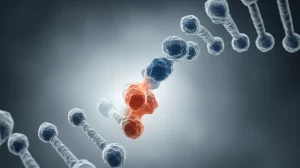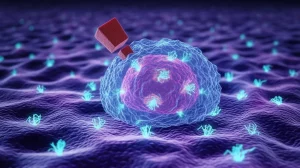Life on the Edge: Unveiling Microbial Secrets in High-Altitude Volcanoes
Hey there! Let me tell you about something truly wild – finding life where you’d least expect it. We’re talking about the absolute edge of existence, places where fire meets ice, high up on active and even extinct volcanoes. These aren’t exactly your cozy spots; they’re called fumarole fields, basically vents puffing out volcanic gases and steam. You’d think nothing could survive there, right? Think again!
Exploring Earth’s Harshest Corners
You know, for the longest time, we thought places like polar ice caps, deep-sea vents, or even the upper atmosphere were just… well, lifeless. Turns out, they’re teeming with tiny organisms, microbes that have figured out how to make a living in conditions that would instantly vaporize or freeze us. Volcanoes, especially those steaming, hissing fumaroles, are another one of these extreme playgrounds. They’re hot, full of weird gases, often metal-rich, and sometimes covered in snow or ice. It’s a tough crowd, and the communities living there are usually pretty low in biomass – meaning not a lot of cells to work with.
Studying these resilient little guys is fascinating because it tells us so much about the limits of life and maybe even where else in the universe we might find it. But, and it’s a big but, getting a clear picture of who’s living there is *really* tricky. Especially when it comes to getting their DNA out for analysis.
The DNA Extraction Headache
Imagine trying to pull microscopic genetic material out of rocky, sandy, sometimes frozen volcanic soil that’s been blasted with heat and chemicals. Not easy! The traditional methods for DNA extraction, which work fine for normal soil or water, often struggle with these extreme samples. You need to break open the microbial cells to get to the DNA inside, a process called lysis. Mechanical lysis, using physical force, is often the go-to for tough cells like bacteria and archaea. But even then, the *way* you bash those cells open can make a difference.
We were curious about this. Could the method of homogenization – basically, how you grind up the sample – actually impact what you find? Especially in these low-biomass, challenging environments? It’s like trying to find specific grains of sand in a huge, complex beach; the tool you use matters. We wanted to see if different tools would give us a different view of the microbial world hidden in these volcanic soils.

Our Volcanic Road Trip (Sort Of)
So, we decided to look at samples from three seriously cool, high-altitude volcanoes: Elbrus in Russia, Ushkovsky, also in Russia but way out in Kamchatka, and the iconic Mount Fuji in Japan. Elbrus and Ushkovsky have active fumaroles, while the Fuji samples were from frozen, extinct fumarole deposits collected years ago. Talk about a temperature range! Elbrus samples were taken from relatively milder spots (+22.5°C soil surface), Ushkovsky from much hotter ones (+68.4°C), and Fuji’s were frozen, though historically they were hot.
We collected soil samples, some from the surface, some from a bit deeper down. For Fuji, we even had frozen core samples. The key was to keep them frozen until we were ready to extract the DNA to preserve the microbial communities as best as possible.
Then came the test: we took portions of these samples and homogenized them using two different machines – one that shakes samples horizontally and one that uses a vertical motion. After that, we followed the standard steps to extract the DNA and then analyzed it using genetic sequencing to see who was there (bacteria, archaea, and fungi) and in what proportions.
Does the Grinder Matter? Turns Out, Yes!
Okay, so the first big finding was about that DNA extraction method. For most of the samples, especially the sandy, rocky ones from Elbrus, the vertical homogenizer gave us *way* more DNA. Like, significantly higher concentrations. It also seemed better at picking up archaea, those ancient, tough-to-lyse microbes, particularly in the Elbrus and Ushkovsky samples. The horizontal one? Not so much, sometimes missing the archaea entirely.
This tells us something important: how you process your sample at the very beginning can totally change your picture of the microbial community, especially in these difficult, low-biomass environments. If your method isn’t efficient at breaking open all the different types of cells, you might be missing a big part of the story. It seems the vertical motion was just better at tackling the specific texture and composition of these volcanic soils and tough microbial cells. The Fuji samples, being frozen volcanic rock fragments (scoria), were the hardest to get DNA from overall, and interestingly, we didn’t find any archaea there with either method. This could be because they weren’t there, or maybe the DNA was too degraded, or perhaps even the vertical method wasn’t quite enough for *that* particular tough sample type.
Life’s Unique Signatures at Each Volcano
Beyond the methodology, we got a peek into the microbial residents of these incredible places. And wow, each volcano had its own distinct microbial vibe!
* Elbrus: This place, with its milder temperatures, had a more diverse bacterial crowd. We saw lots of Acidobacteriota, Pseudomonadota, and Chloroflexota. Archaea from the Crenarchaeota group were also hanging out. It felt more like a mix of typical soil microbes alongside some extremophiles. We even saw slight differences between the surface and deeper layers, suggesting that even small environmental shifts matter.
* Ushkovsky: This was the hot spot (+68.4°C!), and the microbial community reflected that. It was dominated by archaea, specifically Crenarchaeota (Thermoproteota), including groups known to love heat. We also found some heat-loving bacteria like Thermus. It’s a classic thermophilic party up there!
* Fuji: The frozen samples from Fuji had a different bacterial mix – Actinomycetota, Pseudomonadota, and Bacillota were the main players. Interestingly, we found bacteria typically associated with human skin (like Cutibacterium, Staphylococcus) alongside environmental microbes. This might be contamination from sampling or perhaps they can survive in these frozen conditions. No archaea were detected here, which remains a bit of a mystery.
And what about fungi? They were present at all three sites, with Ascomycota, Basidiomycota, and Chytridiomycota being the most common groups, though their exact proportions varied between volcanoes and even depths within Fuji.

The Big Takeaway
So, what did we learn from this adventure on the boundary between ice and fire? First, these high-altitude volcanic fumaroles are unique ecosystems with microbial communities specifically adapted to the intense heat, chemistry, and sometimes freezing conditions. They’re not just surviving; they’re *thriving* in their own way.
Second, the nitty-gritty details of how you collect and process samples, like the type of homogenizer you use for DNA extraction, can significantly influence what you discover. For tough, low-biomass samples from rocky or sandy extreme environments, a vertical homogenization method seems to give a more complete picture, especially for detecting archaea.
Finally, the environment itself – particularly temperature and even depth within the soil – plays a crucial role in shaping which microbes call these extreme places home. The hotter spots favor the heat-loving archaea, while milder areas host a broader mix.
This study is just the beginning of really understanding the life in these incredible volcanic environments. It highlights the unique diversity out there and reminds us that even in the most unlikely places, life finds a way. There’s still so much more to explore and validate, but getting the right tools for the job is clearly step one!
Source: Springer







